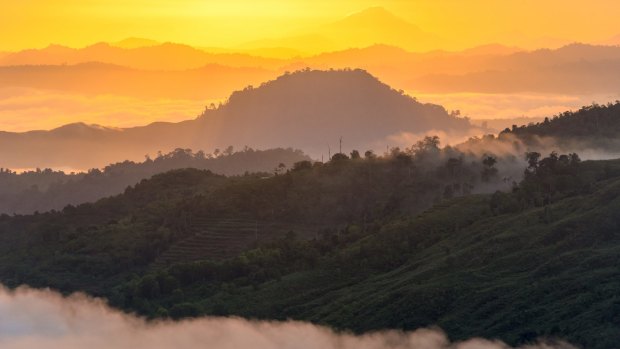This was published 3 years ago
Best travel books to read during coronavirus lockdown: Eight epic travel disasters to take the edge off your wanderlust
By Jen Rose Smith

Not every trip is perfect.Credit: Alamy
"The only aspect of our travels that is guaranteed to hold an audience is disaster," writes journalist Martha Gellhorn in the 1978 memoir Travels with Myself and Another. She proves the point by smelting a lifetime of international mishap into acerbic, funny stories from which readers can't look away. ("Another", in this case, is Gellhorn's sometime husband Ernest Hemingway, called "Unwilling Companion" when he appears in the book.)
And as Gellhorn contends with pit latrines and tropical disease, the present trials of sheltering in place can sound downright cozy in comparison. Her journeys are anything but aspirational: She's one in a long tradition of travel writers whose disastrous encounters serve to discourage venturing out at all. Now, with leisure travel effectively cancelled by the pandemic, they're also a timely distraction from pangs of frustrated wanderlust. Poring over picture postcards, or suppressing the urge to book a plane ticket? Try a bracing round of armchair discomfort, instead.
Travels with Myself and Another: A Memoir, by Martha Gellhorn (1978)
Flyspecked hotel rooms, awful food and endless mechanical failures star in Gellhorn's wryly fond memoir of trips she calls "horror journeys". On and in between reporting assignments, Gellhorn's travels range from rural China to Moscow and Kenya. Stubbornly impervious to wise advice and second thoughts, Gellhorn doesn't miss a thing, even catching dengue fever while camping along Suriname's Saramacca River. She seems to recommend a dose, writing cheerfully that "nothing is better for self-esteem than survival".
The Worst Journey in the World by Apsley Cherry-Garrard (1922)
You could fill whole bookshelves with tales of polar woe, but Cherry-Garrard's memoir of Robert Scott's 1910 Terra Nova Expedition to Antarctica stands out for scenes of unbelievable discomfort and sheer moxie. Tragedy strikes when Scott and his companions perish on the return journey from the South Pole, but the book's most thrilling passage follows Cherry-Garrard's three-man, midwinter journey to collect an unhatched penguin egg. (For science!) The tent blows away; temperatures sink past minus-70; the trio sings songs to buoy their spirits. In his introduction to the book, Cherry-Garrard calls polar exploration "the cleanest and most isolated way of having a bad time". He makes the case.
The Last Train to Zona Verde by Paul Theroux (2013)
Trade a stiff upper lip for a suitcase of gripes on an unabashed misadventure with the grumpy uncle of American travel writing. In the book's early chapters, Theroux sets out on a journey from South Africa to Timbuktu, stirred by nostalgia for his 1963 Peace Corps stint in Malawi. Disenchantment prevails as he bounces between rattletrap taxis and fancy safari lodges, unleashing a volley of complaints at squalor and tourist elitism alike. Moments of wry humour break through his misery. Exhausted, he writes "I let out a ghastly laugh when I thought of anyone saying over my battered corpse, 'He died doing what he loved' ".
Adrift: 76 Days Lost at Sea by Steven Callahan (1986)
A sailing trip from El Hierro to Antigua? It's a one-line poem, the stuff of daydreams. But when Callahan is seven days out from El Hierro, the most westerly of the Canary Islands, a nighttime collision shakes and sinks his custom-made sloop Napoleon Solo. A record-breaking story of survival follows, as Callahan faces down thirst, hunger, despair and curious sharks from the tenuous safety of a tiny life raft. While Callahan's ingenuity is remarkable, his feats are best considered from dry land. Still, he finds beauty at sea: "I am constantly surrounded by a display of natural wonders," he writes. "It is a view of heaven from a seat in hell".
Into the Heart of Borneo by Redmond O'Hanlon (1984)
Before departing on a journey through Borneo's remote Batu Tiban mountains, the naturalist O'Hanlon tallies his fears, among them dysentery, leeches, man-eating crocodiles and 1,700 kinds of parasitic worms. He imagines bringing a rubber suit and steel waders to fend them off. He makes do instead with the poet James Fenton, who hatched the Borneo plan in the first place, plus three bemused local guides to keep the pair alive. The result is calamity and misunderstanding, which O'Hanlon recounts as jungle slapstick. Fenton nearly drowns; O'Hanlon is required, to avoid offending his hosts, to lead a class in the "seven-step disco".

Credit: iStock
North to the Night: A Spiritual Odyssey in the Arctic by Alvah Simon (1998)
Sailors Alvah and Diana Simon set a course for the far north in this frigid tale of adventure aboard their 36-foot sloop Roger Henry. The pair determine to overwinter above the Arctic Circle, but when Diana leaves for an emergency at home, Alvah must weather the season with just a cat named Halifax for company. Dark and biting cold are oppressive, and a polar bear comes sniffing around; throw in some accidental, self-induced carbon monoxide poisoning for the kind of vacation that you need a vacation from.
Journey Without Maps by Graham Greene (1936)
When 30-year-old Graham Greene plans his first trip outside of Europe, he opts for a 350-mile walk through the Republic of Liberia with 26 porters and his cousin Barbara. Retold as a lark, the 1935 journey was actually a secret reporting mission for the Christian Anti-Slavery and Aboriginal Protection Society. At the time, maps of the country were sketchy. A British version left much of the interior blank; one made by the American government filled the space, absurdly, with the word "cannibals". Instead, Greene finds villages ravaged by malaria, plague and poverty. Every conversation turns to contagion. Greene catches what he calls, coyly, "a touch of fever," treating himself in the most English possible way: first with Epsom salts in hot tea, then quinine chased by a glass of whiskey.
The Odyssey by Homer (8th century BC)
Here's a travel tip: When a guy named "trouble" offers you a lift, look for another way home. The Greek King Odysseus - whose name some scholars indeed translate as "trouble" - weathers 10 years of mishaps on what should have been a triumphant sail from Troy to Ithaca. His island-hopping itinerary is the stuff of travel glossies, but losing crew to a Cyclops and a sea monster casts a pall on even the sunniest Aegean charter. If "The Odyssey" is the original travel disaster story, it's also proof that readers love a tale of woe.
The Washington Post
See also: Twenty things you never thought you'd miss about travelling
See also: Ten things you need to know before your first trip overseas
Sign up for the Traveller newsletter
The latest travel news, tips and inspiration delivered to your inbox. Sign up now.